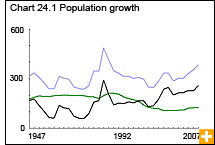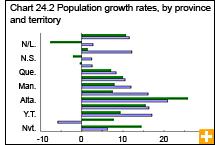Common menu bar links
Population and demography
Archived Content
Information identified as archived is provided for reference, research or recordkeeping purposes. It is not subject to the Government of Canada Web Standards and has not been altered or updated since it was archived. Please contact us to request a format other than those available.
Canada’s population reached 33.3 million as of July 2008, a 10% increase from 30.2 million in 1998.
Largely as a result of net international migration, Canada’s population growth was the highest among the G8 countries from 2001 to 2006. International migration should contribute even more to growth in coming years as the number of deaths is expected to increase with the aging of the baby boomers.
As well, Canada’s fertility rate of 1.6 children per woman is well below the replacement level of 2.1. By contrast, levels in the United States have generally been at 2.1 children per woman.
Our population is aging and Canadians are living longer. In 2005, life expectancy was 78.0 years for males and 82.7 years for females.
From 1956 to 2006, the median age of the Canadian population went from 27.2 years to 38.9, a gain of more than 10 years over a span of half a century. By 2056, the median age is expected to reach 46.9 years, almost 20 years higher than it was in 1956.
Around 2015, for the first time in Canada’s history, there could be more people aged 65 and older than children under the age of 15. In 2031, 8.9 million to 9.4 million Canadians will be aged 65 and older, whereas the number of children is expected to be about half that number, from 4.8 to 6.6 million.
Where the people live
Most Canadians live in a narrow corridor in the southern part of the country, near the American border. In 2008, 62% of the population lived in Quebec and Ontario, the two most populous provinces.
The Northwest Territories, Yukon and Nunavut represent 39% of the continental mass of Canada. Their inhabitants make up 0.3% of the population.
In most provinces, population growth depends mainly on immigration, whereas the population growth of Nunavut is due primarily to a total fertility rate of 2.8 children per woman, nearly twice the national rate. Although it has the highest natural growth in the country, Nunavut posted the lowest growth rate in its brief history in 2008, attributable to losses from interprovincial migration.
In 2007/2008, population growth was strongest in Canada’s western provinces. Despite a decline in net interprovincial migration, Alberta’s population grew 2.1%, almost twice the national average of 1.2%, and Alberta remained the province with the strongest population growth for the seventh consecutive year. British Columbia was second at 1.7%. Saskatchewan ranked third and led other provinces in the rate of interprovincial migration for the first time in recent history.
Prince Edward Island was the only province east of Ontario to exceed the national average growth. The population of Newfoundland and Labrador rose in 2007/2008, the first increase since 1991/1992.
Most Canadians live in urban areas. According to the 2006 Census, nearly 25 million people, more than 80% of Canada’s population, live in cities. The majority of urban dwellers (21.5 million people) live in one of the 33 census metropolitan areas (CMAs).
Six CMAs have a population of more than 1 million—Toronto, Montréal, Vancouver, Ottawa–Gatineau, Calgary and Edmonton. Combined, these six urban areas are home to 14.1 million people, or 45% of the population.




